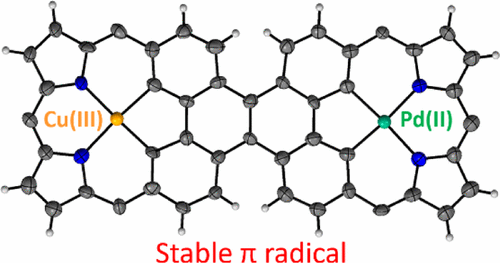当前位置:
X-MOL 学术
›
J. Am. Chem. Soc.
›
论文详情
Our official English website, www.x-mol.net, welcomes your
feedback! (Note: you will need to create a separate account there.)
Hetero Cu(III)-Pd(II) Complex of a Dibenzo[g,p]chrysene Fused Bis-dicarbacorrole with Stable Organic Radical Character
Journal of the American Chemical Society ( IF 14.4 ) Pub Date : 2017-10-12 , DOI: 10.1021/jacs.7b09167 Xian-Sheng Ke 1 , Yongseok Hong 2 , Peiyu Tu 1 , Qing He 1 , Vincent M. Lynch 1 , Dongho Kim 2 , Jonathan L. Sessler 1
Journal of the American Chemical Society ( IF 14.4 ) Pub Date : 2017-10-12 , DOI: 10.1021/jacs.7b09167 Xian-Sheng Ke 1 , Yongseok Hong 2 , Peiyu Tu 1 , Qing He 1 , Vincent M. Lynch 1 , Dongho Kim 2 , Jonathan L. Sessler 1
Affiliation

|
Bis-dicarbacorrole (bis-H3) with two adj-CCNN subunits was synthesized by incorporating a dibenzo[g,p]chrysene moiety into the macrocyclic structure. The two trianionic cores in bis-H3 can stabilize two Cu(III) ions (bis-Cu) or concurrently a Cu(III) cation and a Pd(II) ion in the form of a hetero bis-metal complex (mix-Cu/Pd). As prepared, mix-Cu/Pd displays organic π radical character, as confirmed by various techniques, including electron paramagnetic resonance spectroscopy, cyclic voltammetry, femtosecond transient absorption measurements, and DFT calculations. Radical formation is ascribed to one-electron transfer from the dicarbacorrole backbone to the Pd center allowing the d8 Pd(II) center to be accommodated in a square planner coordination geometry. Nucleus-independent chemical shift and anisotropy of the induced current density calculations provide support for the conclusion that bis-H3 and bis-Cu both display antiaromatic character and contain two formally 16 π-electron dicarbacorrole subunits. On this basis, we suggest that mix-Cu/Pd is best considered as containing a fused 15 π-electron nonaromatic radical subunit and a 16 π-electron antiaromatic subunit. The spectroscopic observations are consistent with these assignments.
中文翻译:

具有稳定有机自由基特征的二苯并[g,p]芘稠合双-二甲克唑的杂Cu(III)-Pd(II)配合物
具有两个 adj-CCNN 亚基的双二卡巴克罗 (bis-H3) 是通过将二苯并 [g,p]chrysene 部分合并到大环结构中来合成的。双 H3 中的两个三阴离子核可以稳定两个 Cu(III) 离子 (bis-Cu) 或同时稳定一个 Cu(III) 阳离子和一个 Pd(II) 离子,以异质双金属络合物的形式 (mix-Cu) /钯)。制备后,mix-Cu/Pd 显示出有机 π 自由基特征,这已被各种技术证实,包括电子顺磁共振光谱、循环伏安法、飞秒瞬态吸收测量和 DFT 计算。自由基的形成归因于从二卡巴克罗骨架到 Pd 中心的单电子转移,允许 d8 Pd(II) 中心容纳在方形平面配位几何中。诱导电流密度计算的与核无关的化学位移和各向异性为双-H3 和双-Cu 都显示出抗芳香性并包含两个形式上的 16 π-电子二碳甲咯咯亚基的结论提供支持。在此基础上,我们建议最好将混合铜/钯视为包含稠合的 15 π 电子非芳香族自由基亚基和 16 π 电子反芳香族亚基。光谱观察与这些分配一致。
更新日期:2017-10-12
中文翻译:

具有稳定有机自由基特征的二苯并[g,p]芘稠合双-二甲克唑的杂Cu(III)-Pd(II)配合物
具有两个 adj-CCNN 亚基的双二卡巴克罗 (bis-H3) 是通过将二苯并 [g,p]chrysene 部分合并到大环结构中来合成的。双 H3 中的两个三阴离子核可以稳定两个 Cu(III) 离子 (bis-Cu) 或同时稳定一个 Cu(III) 阳离子和一个 Pd(II) 离子,以异质双金属络合物的形式 (mix-Cu) /钯)。制备后,mix-Cu/Pd 显示出有机 π 自由基特征,这已被各种技术证实,包括电子顺磁共振光谱、循环伏安法、飞秒瞬态吸收测量和 DFT 计算。自由基的形成归因于从二卡巴克罗骨架到 Pd 中心的单电子转移,允许 d8 Pd(II) 中心容纳在方形平面配位几何中。诱导电流密度计算的与核无关的化学位移和各向异性为双-H3 和双-Cu 都显示出抗芳香性并包含两个形式上的 16 π-电子二碳甲咯咯亚基的结论提供支持。在此基础上,我们建议最好将混合铜/钯视为包含稠合的 15 π 电子非芳香族自由基亚基和 16 π 电子反芳香族亚基。光谱观察与这些分配一致。













































 京公网安备 11010802027423号
京公网安备 11010802027423号